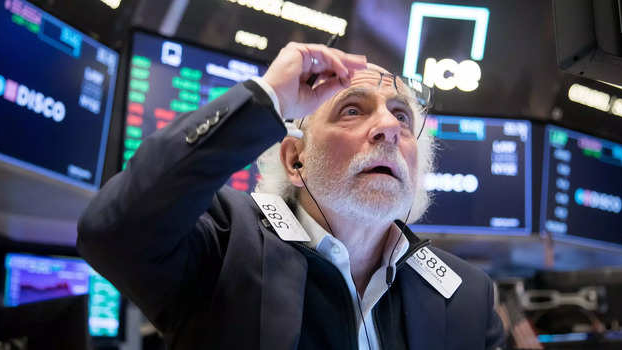
A trader works at the New York Stock Exchange in New York, U.S., March 9, 2022. /Xinhua
A trader works at the New York Stock Exchange in New York, U.S., March 9, 2022. /Xinhua
Editor's note: Thomas W. Pauken II, the author of the book "U.S. vs. China: From Trade War to Reciprocal Deal," is a consultant on Asia-Pacific affairs and a geopolitical commentator. The article reflects the author's opinions and not necessarily the views of CGTN.
The world as we know it may never be the same again since the composite indexes of stock exchanges across the globe plunged on Monday. The Standard & Poor's (S&P) 500 dropped 151.23 points – or 3.9 percent – to 3749.63. The Dow Jones Industrial Average (DJIA) fell 876.05 points – or 2.8 percent – to 30516.74 and the Nasdaq Composite sunk 530.80 points – or 4.7 percent – to 10809.23.
The European and Asian stock markets took deep dives yesterday as well. The pan-continental Stoxx Europe 600 dropped 2.4 percent while the UK's FTSE plunged 1.5 percent. Additionally, Hong Kong's Hang Seng, Japan's Nikkei 225 and South Korea's Kospi Composite all had dropped by 3 percent or more. But Shanghai's CSI 300 index had undergone a softer landing with a 1.2 percent fall.
Casual observers might conclude Monday's stock index crashes are not a big deal. Stock prices have spiraled up and down in wild fluctuations in recent years, but when reviewing the trends and charts it's obvious to all investors that the prospects look awful and we are headed for a bear market (stock market down cycle).
The ominous stock market downturn has only happened seven times before in the U.S. in the past 50 years, with the last two events occurring during the 2007 to 2008 global financial crises and with the COVID-19 pandemic in 2020.
Nonetheless, one should take note that economists and financial experts believe the stock markets are known as six-month indicators, meaning the stock index values going up and down would signal the direction of the economy six months later. Hence, stock market crashes could foretell the onset of a recession. But don't be surprised if much worse is still to come, such as an economic depression.
By reviewing the official data and geopolitical trends, the international economy overall is sailing toward unchartered and stormy seas, and there could be no turning back.
Inflation turns its ugly head
The most significant challenge for national and regional economies for the moment is the huge spike in inflation rates and they are no longer transitory. This buzz word – transitory – was hyped by U.S. Secretary of Treasury Janet Yellen last year as she advised the White House to move forward on the government's COVID-19 stimulus spending, arguing that inflation rates in the U.S. would likely drop back to below 2 percent in the near future.
Consequently, the U.S. Congress and the Biden administration approved a COVID-19 federal stimulus bill valued at around $1 trillion. Accordingly, U.S. citizens went on a massive spending spree in the first quarter of 2022, although global manufacturers, supply chains and retailers were not prepared to handle the huge upsurge in consumer demand. The U.S. inflation rate rose to 8.6 percent in May.
The severe supply chain disruptions were also a shock to the system, such as long delays at the Long Beach Port in California. Cargo ships importing goods from the Asian markets had to wait 15 to 20 days or even longer in a queue to have their products unloaded. The logjams at U.S. West Coast ports continued last year for over six months.
Meanwhile, a series of other black swan incidents (unexpected bad news events) caused deepening problems for the global economy. In February, the U.S. FDA (Food & Drug Administration) temporarily shut down the nation's largest factory for producing baby formula in Michigan. The factory remained closed for about five months and led to severe baby formula shortages at most grocery stores nationwide.

A gas station in the Brooklyn borough of New York, U.S., June 10, 2022. /Xinhua
A gas station in the Brooklyn borough of New York, U.S., June 10, 2022. /Xinhua
Food and energy shortages loom ahead
At the beginning of this year, Washington was setting the groundwork to resolve chronic global supply chain disruptions as well as to lower inflation rates with the U.S. Federal Reserve Bank, the nation's central bank, implementing a policy of incremental increases on interest rates to tighten monetary policy without inflicting severe pain on the U.S. economy.
Yet such plans were doomed after Russian President Vladimir Putin announced the "special military operation" in Ukraine on February 24. In the immediate aftermath, Western powers imposed game-changing economic sanctions on Russia.
However, the sanctions – which were intended to cripple the Russian economy – have backfired, big-time. Russia is a major exporter of oil and gas, fertilizer, minerals and food. By cracking down on the Kremlin, U.S. citizens are paying record-high prices at the gas pump, while logistics services companies are getting hammered as they must pay substantially more for transportation and delivery costs.
American farmers are running out of fertilizer, making it harder for them to grow crops. This spring, a severe drought and record-breaking heat waves swept across the U.S. Midwest.
Accordingly, food and energy shortages have become more inevitable as shoppers are coming across more empty shelves at stores and there are rising threats of rolling black outs in major U.S. cities this summer. The demand for electricity soars on hot days, but power plants in the country can't keep up with demand.
No painless cure for the foreseeable future
Two major structural problems are at play causing the U.S. economy to stumble: high inflation rates and supply shortages. The Biden administration has refused to resolve the problem as it realizes the big fix will be very painful.
To tackle high inflation requires the U.S. Federal Reserve to get more aggressive at raising interest rates. This week the Federal Reserve Board will have a two-day meeting, and experts forecast Fed chairman Jerome Powell to announce a 0.5 to 0.75 percent basis point benchmark rate hike.
But truth be told that's too little too late. Powell has not shown the courage in prior years to take bold stands while leading the Federal Reserve, and it's doubtful he will raise interest rates to the level that can pop the inflation bubble. Additionally, such actions would ultimately lead to a recession, and the Biden administration lacks the fortitude to withstand the pressures.
We are likely to see slow and steady interest rate hikes by the Fed while inflation rates could rise above the 10 percent mark in the second half of the year. Biden's refusal to end the economic sanctions on Russia will lead to more catastrophic results as well for the U.S. economy. Hence, the dark times for the United States look here to stay for another year or two, and that's being optimistic.
(If you want to contribute and have specific expertise, please contact us at opinions@cgtn.com. Follow @thouse_opinions on Twitter to discover the latest commentaries in the CGTN Opinion Section.)

